Hydrogen Plant Financial Model
Financial Model for a Hydrogen Plant
This 20 year model involves detailed revenue projections, cost structures, capital expenditures, and financing requirements. The model provides a thorough understanding of the financial viability, profitability, and cash flow position of the plant. Includes Hydrogen sales revenue, by product revenue, and gained subsidies: 20x Income Statements, Cash Flow Statements, Balance Sheets, CAPEX sheets, OPEX Sheets, Statement Summary Sheets, and Revenue Forecasting Charts with the specified revenue streams, BEA charts, sales summary charts, employee salary tabs and expenses sheets. Over 140 spreadsheets in 1 Workbook for close monitoring of your Hydrogen Plant financials.
Income Statement (Profit & Loss Statement)
The Income Statement summarizes revenues, costs, and profit over a specific period (typically annually or quarterly).
1. Revenue
Hydrogen Sales Revenue:
Price per kg × Volume produced and sold (e.g., kg/year)By-product Revenue (if applicable):
Oxygen or excess power sold back to the grid
2. Cost of Goods Sold (COGS)
Feedstock Costs:
Electricity (for electrolysis or other process)
Water (for electrolysis)
Natural gas (if using steam methane reforming)
Operating Labor Costs
Maintenance & Consumables
Spare Parts
3. Gross Profit
Gross Profit=Revenue−COGS\text{Gross Profit} = \text{Revenue} – \text{COGS}Gross Profit=Revenue−COGS
4. Operating Expenses
Salaries & Administration
Insurance
Permits and Licensing
R&D (if applicable)
5. EBITDA (Earnings Before Interest, Taxes, Depreciation & Amortization)
6. Depreciation & Amortization
Based on capital expenditure (CapEx) and asset life
7. EBIT (Operating Income)
8. Interest Expense
Based on loan amortization schedules
9. Pre-Tax Income
10. Taxes
Corporate income tax (adjusted for tax credits or green incentives)
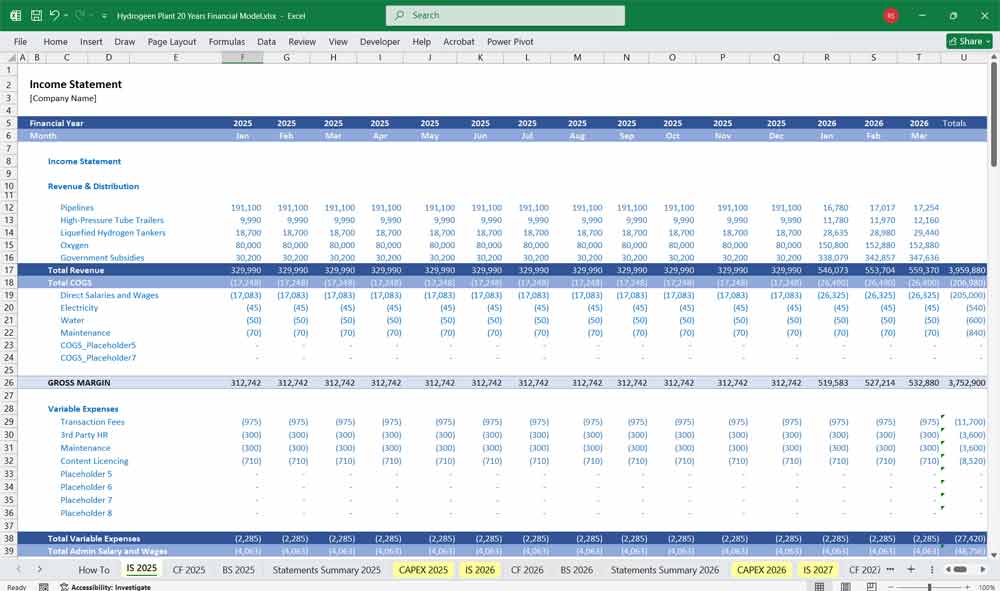
Hydrogen Plant Cash Flow Statement
This shows actual cash movement, divided into Operating, Investing, and Financing activities.
A. Operating Cash Flow
Net Income
+ Depreciation/Amortization (non-cash)
+/- Changes in Working Capital:
Inventory
Receivables
Payables
Operating Cash Flow: True cash from operations
B. Investing Cash Flow
Capital Expenditures (CapEx):
Electrolyzers, compressors, storage tanks, piping, control systems, etc.
Plant Expansion or Upgrades
Asset Disposals (if any)
C. Financing Cash Flow
Debt Issued or Repaid
Equity Raised
Interest Paid
Dividends Paid
D. Net Cash Flow
Net Cash Flow=A + B + C\text{Net Cash Flow} = \text{A + B + C}Net Cash Flow=A + B + C
E. Cash at Beginning & End of Period
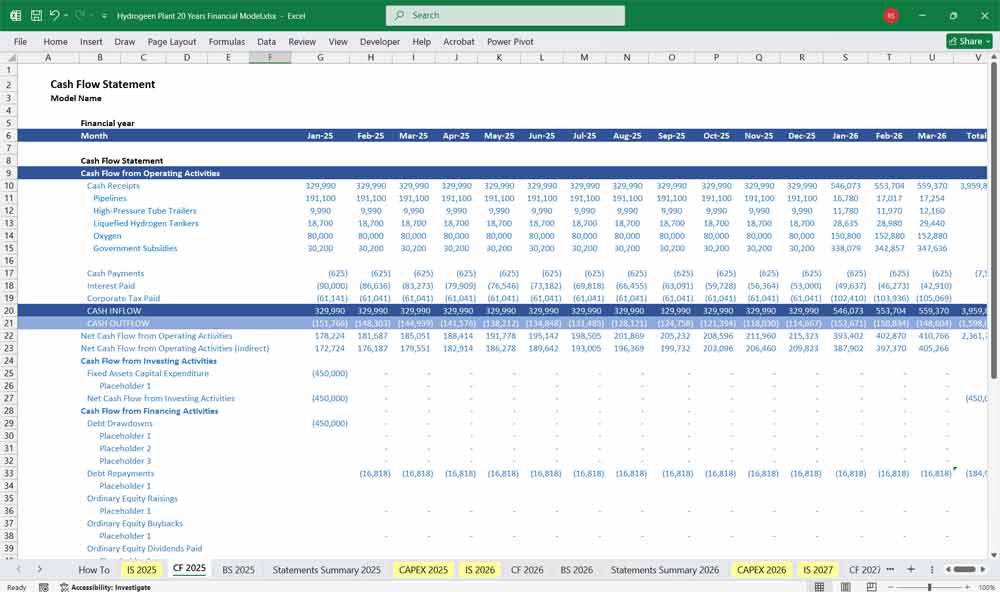
Hydrogen Plant Balance Sheet
The Balance Sheet reflects the company’s financial position at a specific point in time.
Assets
1. Current Assets
Cash and Cash Equivalents
Accounts Receivable
Inventory (hydrogen stored, spare parts)
Prepaid Expenses
2. Non-Current Assets
Property, Plant & Equipment (PP&E):
Electrolyzers
Storage and distribution infrastructure
Land
Accumulated Depreciation
Intangible Assets (if applicable)
Deferred Tax Assets
Liabilities
1. Current Liabilities
Accounts Payable
Short-Term Loans/Leases
Accrued Expenses
2. Long-Term Liabilities
Long-Term Debt
Deferred Tax Liabilities
Lease Obligations
Equity
Common Stock
Additional Paid-In Capital
Retained Earnings
Equity Contributions (if from strategic partners or government grants)
Accumulated Other Comprehensive Income
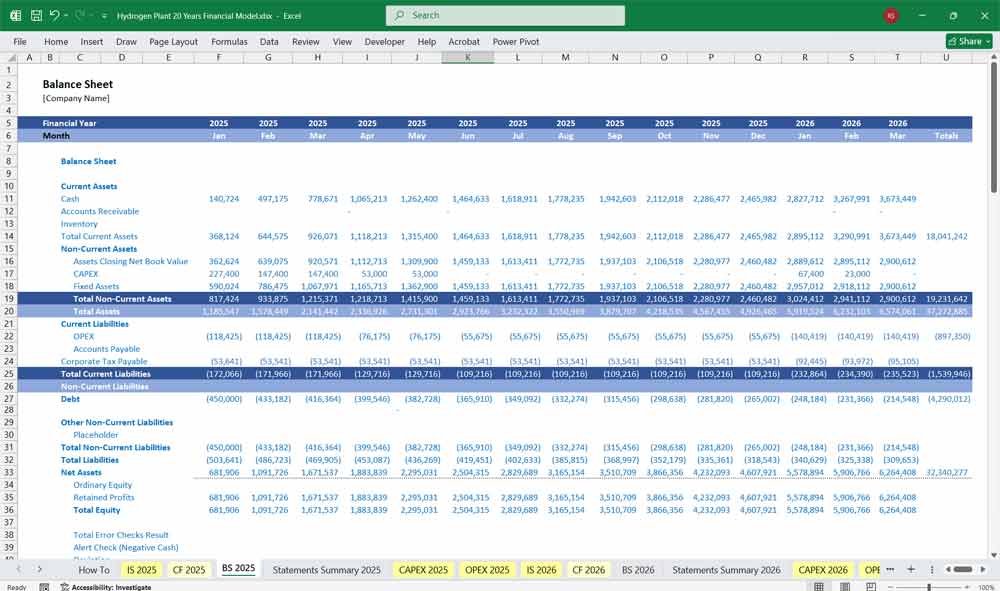
Key Supporting Schedules (used across statements)
Production Schedule: Hydrogen Plant uptime, capacity utilization, degradation
Price Forecasts: Electricity, hydrogen selling price, feedstock inputs
CapEx Schedule: Timing of investment, inflation, replacement cycles
Debt Schedule: Repayment terms, interest rate, covenants
Tax Schedule: Tax rates, tax credit schemes (e.g., green hydrogen subsidies)
Working Capital Assumptions: Days receivable, inventory turnover, etc.
Pipeline Distribution at a Hydrogen Plant & Impact of Cost Fluctuations
Pipeline distribution used in this financial model is a common and efficient method for transporting hydrogen from production plants to end-users, such as industrial facilities, refineries, or fueling stations. Unlike truck or rail transport, pipelines offer lower long-term operating costs and higher delivery volumes, making them ideal for large-scale hydrogen projects. However, pipeline infrastructure requires significant upfront capital expenditure (CapEx) for construction, compression stations, and safety systems, along with ongoing maintenance costs.
Hydrogen Plant Cost Fluctuation
Fluctuations in key cost drivers—such as electricity prices (for compression), steel prices (for pipeline materials), and labor costs—can directly impact operational expenses, reducing profit margins if not offset by higher hydrogen prices. Additionally, if hydrogen market prices decline due to oversupply or policy changes, be sure to analyse revenue within the financial model to cover rising distribution costs, and make sure this doesn’t negatively affect the plant’s financial viability. To mitigate these risks, operators often secure long-term supply contracts with price escalation clauses or hedge against volatile energy inputs.
Liquefied Hydrogen Tanker Distribution & Financial Model Impact
Liquefied hydrogen tankers provide a flexible distribution solution for hydrogen plants, particularly when pipeline infrastructure is unavailable or uneconomical. Unlike gaseous hydrogen transport, liquefaction reduces volume, enabling more efficient long-distance delivery. However, this method involves high energy costs for cryogenic cooling (to -253°C) and specialized insulated tankers, leading to significant variable transport expenses. Fluctuations in fuel prices (affecting trucking/shipping costs), electricity rates (impacting liquefaction energy needs), and maintenance expenses for cryogenic equipment can substantially alter operational costs.
Pricing Variables With A Hydrogen Plant
In a financial model, these variables directly affect the Cost of Goods Sold (COGS) and gross margins, particularly if hydrogen sales contracts lack price adjustments. Rising transport costs without corresponding revenue increases can erode profitability, while lower-than-expected demand may leave tankers underutilized, further straining unit economics. Sensitivity analysis should assess break-even transport costs and potential hedging strategies (e.g., fixed-price fuel contracts) to stabilize cash flows.
Oxygen Byproduct Revenue at a Hydrogen Plant & Financial Model Implications
Many hydrogen production methods, particularly electrolysis, generate oxygen as a byproduct, which can be captured and sold to industrial users (e.g., medical applications, steel manufacturing, or wastewater treatment). This additional revenue stream helps offset production costs and improves the plant’s overall economics. However, oxygen revenue is subject to market fluctuations—price volatility depends on regional demand, competing suppliers, and industrial activity levels.
Revenue Fluctuaton And Your Hydrogen Plant
In a financial model, variations in oxygen pricing or sales volume directly impact total revenue and gross profit margins. If oxygen prices decline due to oversupply or reduced demand, the plant’s profitability may weaken unless hydrogen revenues compensate. Conversely, strong oxygen markets enhance cash flow and reduce payback periods. Sensitivity analysis should assess scenarios where oxygen revenue drops by 20-30%, testing the model’s resilience. Additionally, storage or purification costs for oxygen (if not immediately sold) must be factored into operating expenses to avoid overestimating net benefits. Including conservative oxygen revenue assumptions ensures a more robust financial projection.
Electrolyzer Construction at a Hydrogen Plant & CAPEX Sensitivity to Cost Variations
The construction of an electrolyzer system represents a major component of a hydrogen plant’s capital expenditure (CAPEX), with costs influenced by three key variables: engineering design, equipment procurement, and installation. Engineering costs, which include feasibility studies, process design, and permitting, can fluctuate based on project complexity and regulatory requirements. Equipment costs—such as electrolyzer stacks, power converters, and balance-of-plant systems—vary with technology type (ALK, PEM, or SOEC), supplier pricing, and scale efficiencies.
Variable Expenses At A Hydrogen Plant
Installation expenses, covering labor, civil works, and commissioning, are sensitive to regional labor rates, site conditions, and logistical challenges. If any of these cost categories exceed initial estimates—due to supply chain delays, inflation, or design changes—the total CAPEX can escalate significantly, impacting project feasibility. For instance, a 20% increase in electrolyzer equipment costs alone could raise CAPEX by millions, extending the payback period or requiring additional financing. To mitigate risks, financial models should incorporate contingency buffers (10-15%) and scenario analysis to assess CAPEX sensitivity, ensuring robust project planning and investor confidence.
Hydrogen Storage Tanks at a Hydrogen Plant & CAPEX
Hydrogen storage tanks are a critical component of a hydrogen plant’s infrastructure, ensuring supply stability and operational flexibility. The capital expenditure (CAPEX) for these tanks is influenced by three primary cost drivers: engineering design, equipment procurement, and installation. Engineering costs cover tank specifications, safety compliance, and integration with production systems, which can vary based on pressure requirements (low-pressure gaseous vs. cryogenic liquid storage) and regulatory standards.
CAPEX And A Hydrogen Plant Startup
Equipment costs depend on storage type (e.g., composite vessels for high-pressure gas or vacuum-insulated tanks for liquid hydrogen), material prices (e.g., carbon fiber or stainless steel), and supplier market conditions. Installation expenses, including site preparation, foundation work, and system integration, are subject to labor rates, logistical challenges, and geographic factors. If any of these cost categories exceed projections—due to design changes, supply chain disruptions, or unforeseen site conditions—the total CAPEX can rise substantially, impacting the project’s financial viability. For example, a 15% increase in composite tank costs or higher-than-expected installation labor rates could significantly inflate upfront investments, delaying ROI. To manage these risks, financial models should incorporate cost contingencies (10-20%) and scenario testing to evaluate CAPEX resilience under varying price and execution conditions. This ensures more accurate budgeting and investor confidence in the project’s economic feasibility.
Electrolyzers dominate the cost variation impact, making them the most critical component to control in project budgeting within a financial model environment.
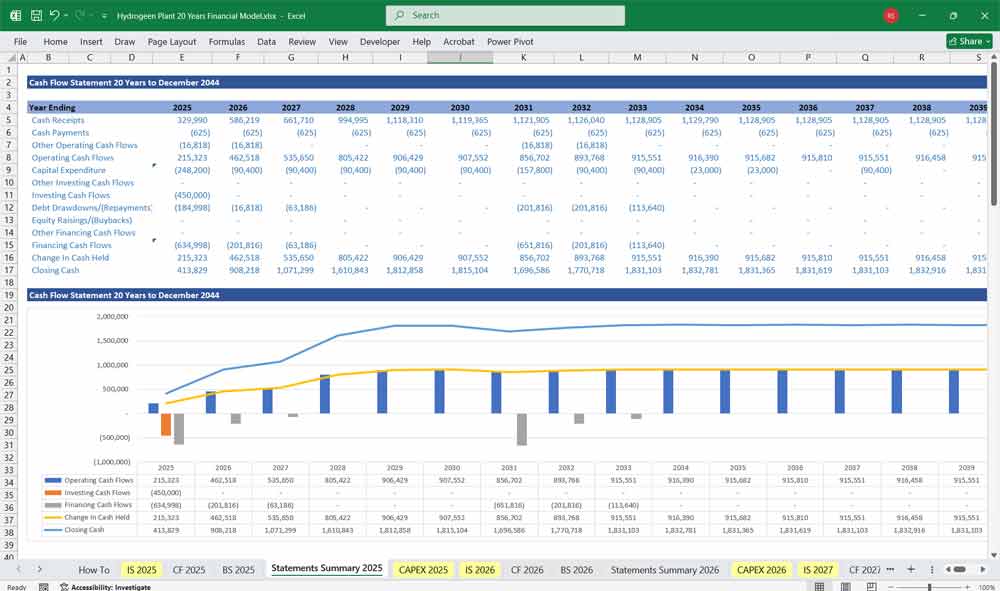
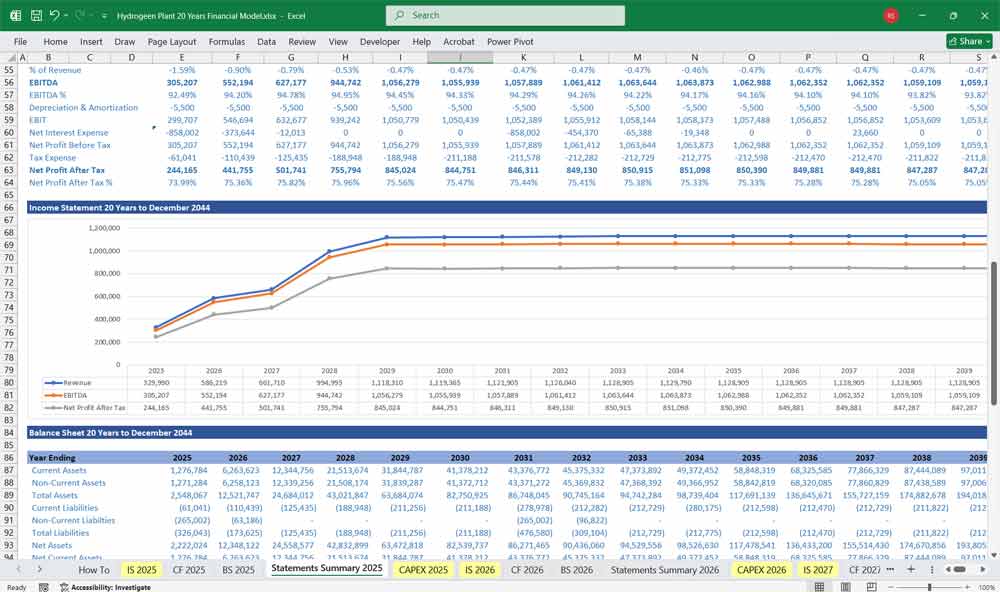
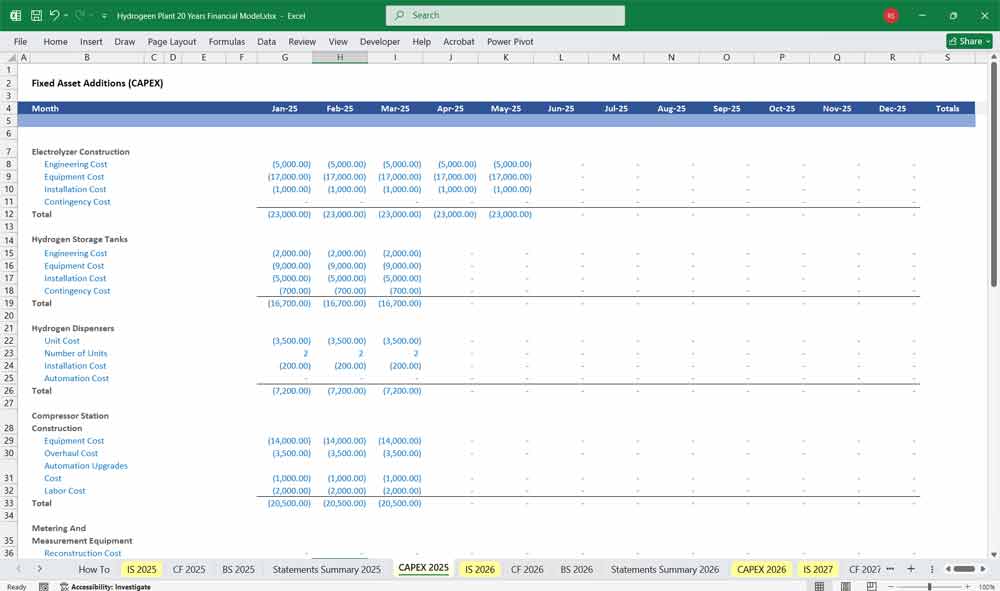
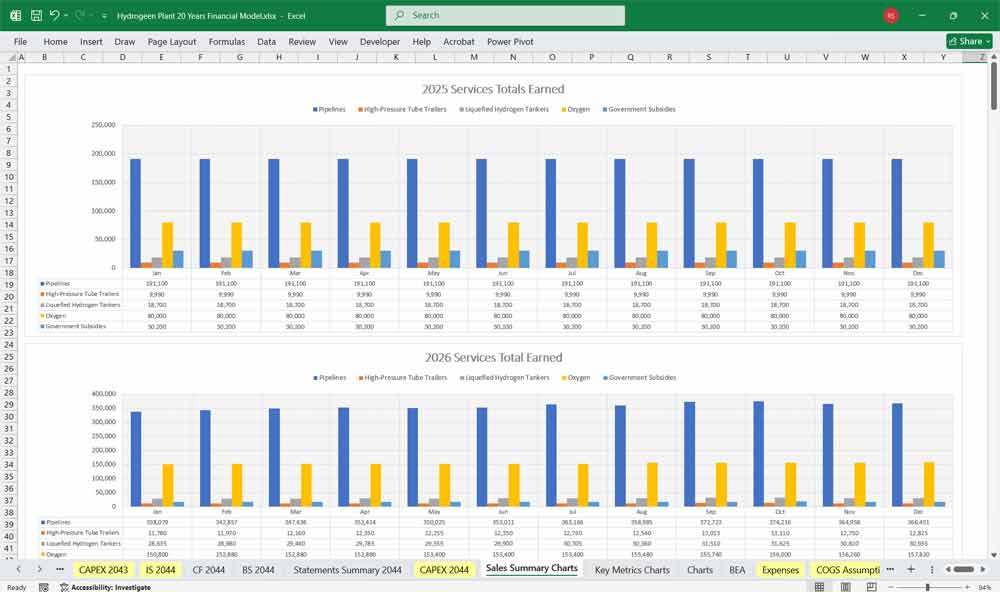
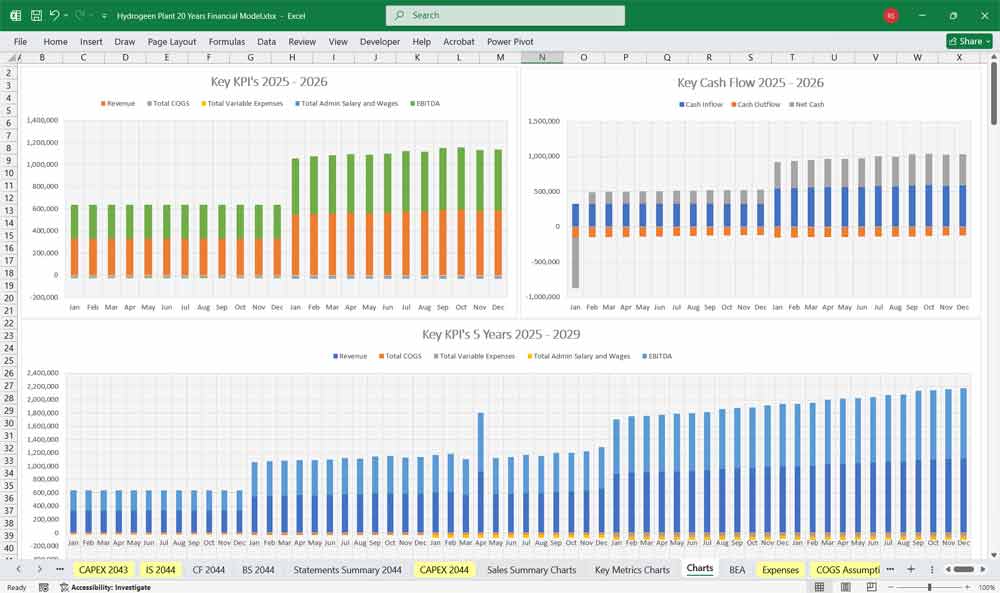
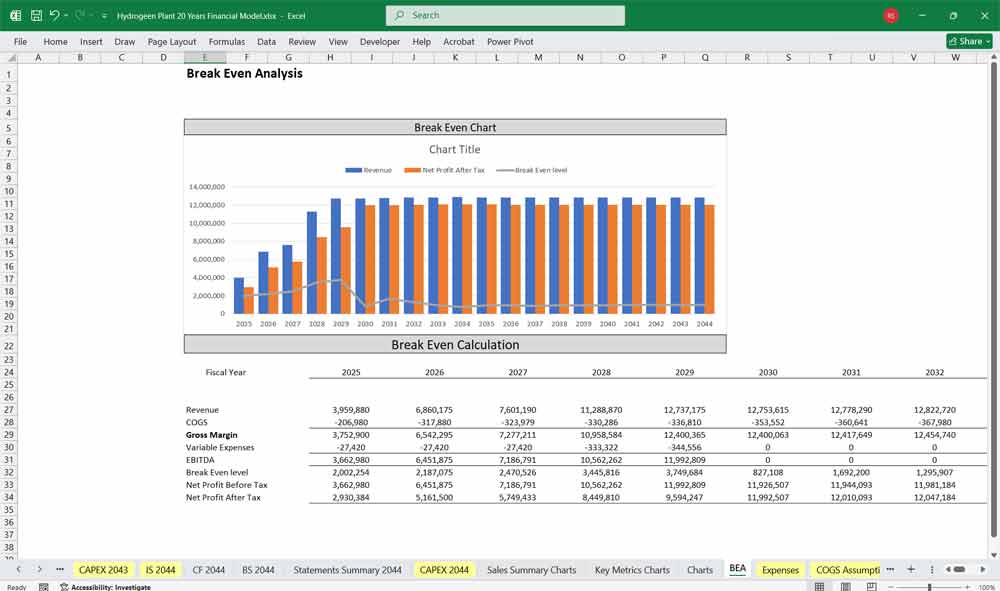
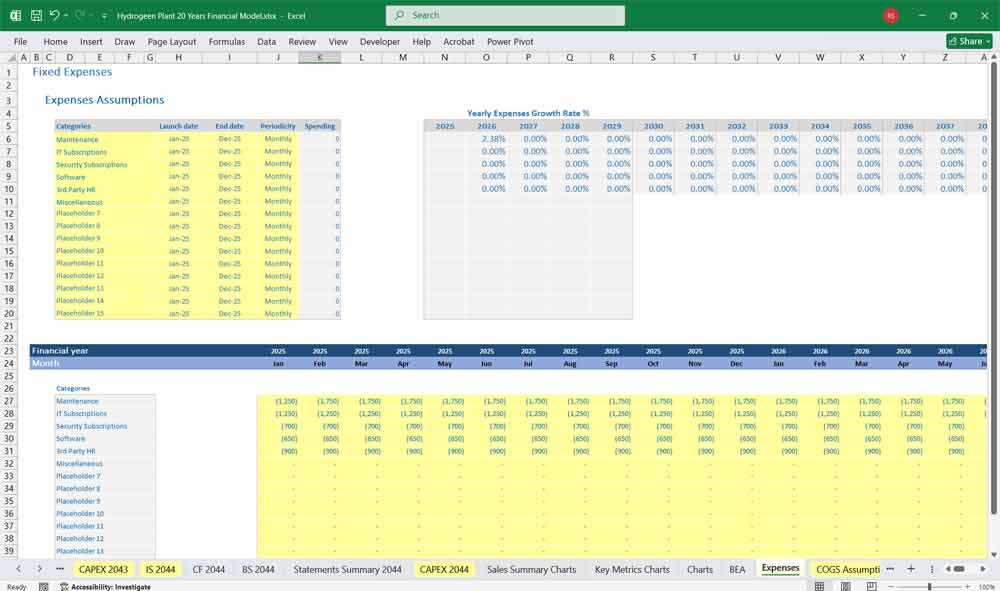
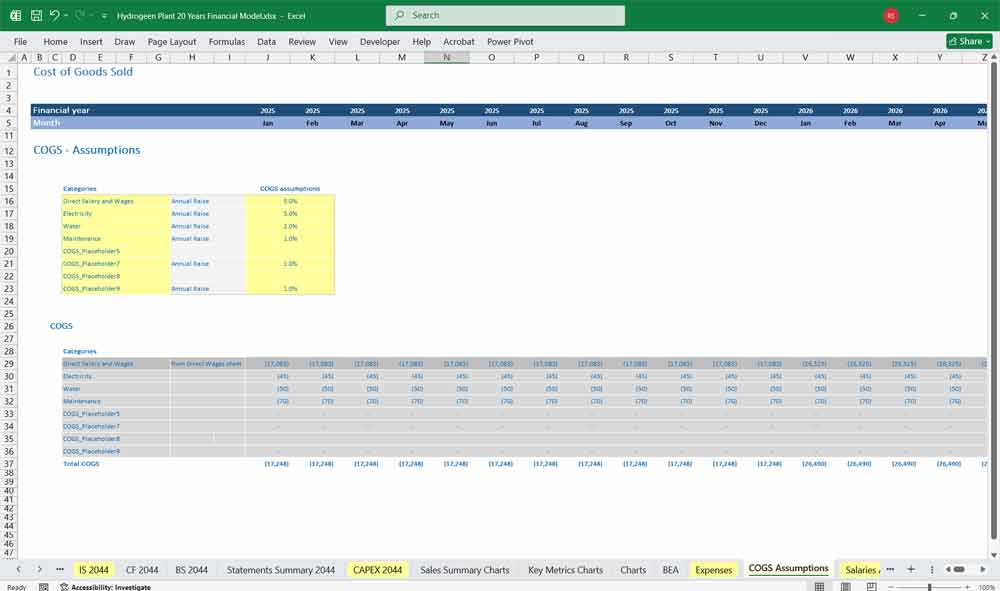
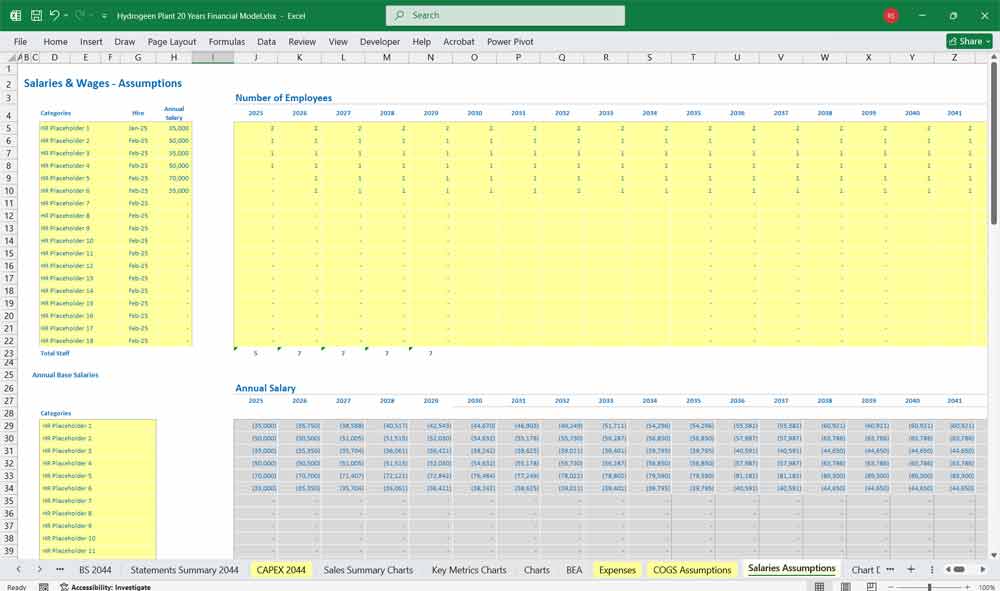
Additional Notes
Levelized Cost of Hydrogen (LCOH) is often calculated to benchmark economic viability.
Sensitivity Analysis should test variables like hydrogen price, electricity cost, CapEx, and plant utilization.
Scenario Analysis may include regulatory changes, carbon pricing, or demand shifts.
Final Notes on the Financial Model
This 20-Year Hydrogen Plant Financial Model helps to focus on balancing capital expenditures with steady revenue growth from diversified distribution services. By optimizing operational costs, power efficiency, and maximizing high-margin services, the model ensures sustainable profitability and cash flow stability.
Download Link On Next Page
